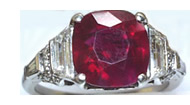Ruby
 Ruby's
name comes from the Latin word rubinus, red. Both ruby and sapphire
come from the species corundum, but the stone is called ruby only if its color
is one of four hues: orangey red, red, slightly purplish red, or purplish
red. Otherwise it is a sapphire. For certain shades,
only a trained expert can distinguish ruby from sapphire. In general, ruby
is far more valuable than sapphire.
Ruby's
name comes from the Latin word rubinus, red. Both ruby and sapphire
come from the species corundum, but the stone is called ruby only if its color
is one of four hues: orangey red, red, slightly purplish red, or purplish
red. Otherwise it is a sapphire. For certain shades,
only a trained expert can distinguish ruby from sapphire. In general, ruby
is far more valuable than sapphire.

In the corundum Rainbow Bracelet, the red stones are rubies.
All the others are sapphires.
Many of the so-called rubies throughout history were actually spinel. Modern technology has revealed that "The Mogul Ruby," listed in science books as one of the greatest rubies, is spinel. Many other common gemstones, among them garnet, tourmaline and red beryl, have also been mistakenly labeled rubies.
Rubies typically range from .01 to 5.00 carats, but stones of several hundred carats also occur. Large flawless rubies are scarce and costly. Smaller stones may be purchased at moderate prices. Rubies are very resistant to breakage. Burma ruby is considered the rarest and most costly of fine gem quality ruby.
Ruby Treatments
Rubies are usually heated to improve their color and appearance. The enhancement is quite stable and no special care is needed with the stone.
Other treatments are common practice in dealing with rubies and they should be specifically disclosed.
Treatments That Should Be Disclosed
- Surface Cavities Filled A foreign material, such as glass, is used to fill surface fractures. The danger is that the foreign material will simply fall out.
- Dyed with Colored Oil Oiling is a way to fill surface fractures as well as enhance the gem's color. It used to be a rare practice but is becoming quite widespread as a way to make low quality rubies more attractive. Oil fillers are less stable than glass used as fillers. The oils evaporate over time, leaving an unattractive stone with very visible fractures.
- Diffusion The ruby is subjected to chemicals and high temperatures to produce a shallow subsurface layer of color. Diffusion may also create inclusions that produce asterism, an attractive star-like effect. The treatment's stability is good if the stone is not repolished or recut.
See also Gemstone Treatments.
Shopping Considerations and Caveats
- Ask whether or not the ruby has been treated. All enhancements except heating should be disclosed on the sales receipt and on the appraisal. If the ruby was not heated, then that should be stated, since a ruby that is not heat-treated is more valuable than one that is.
- Ultrasonic cleaning or chemicals can damage rubies.
- Laboratory-grown rubies are widely available. When comparison shopping, be sure to ask whether the ruby is natural or synthetic. Synthetic gems have a far lower value.
- For rubies tending toward pink, verify that the stone is ruby and not pink sapphire.
- Certificate: read about colored gem certificates and see a sample of a ruby certificate
